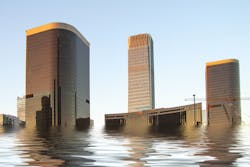Is Your Building Ready for Climate Change Impacts?
Climate change has dominated headlines for years now, but are people really worried about it? More importantly, have they been impacted by it, and if so, how much has it affected their quality of life? And do community planners, building owners and homeowners understand the impact the climate could have on their properties?
These are questions not many have asked—until recently, that is. A new report from the Gensler Research Institute outlines a framework for how communities and cities can be strategically designed to minimize the negative impacts of global climate change and protect their properties from severe weather events. And the timing couldn’t be better, because climate change is no longer a concern for the future: it’s a present-day reality.
Survey Says … We’re Not Ready
According to the U.S. Climate Action Survey 2022, U.S. adults indicate that they are currently being negatively impacted by changing weather patterns. Of the 2,756 respondents surveyed, 87% report to have been personally impacted by extreme weather events since 2019; however, only 18% believe their communities are built to withstand climate change.
The survey also found that 62% of U.S. homeowners say they have already experienced disruptions to their daily lives as a result. Of those who have been impacted by extreme weather, 82% are open to making changes with their homes, with cost being the biggest barrier to making changes.
“The communities we live in need to have a plan for the future of the economy and effectively avoiding life interruption and business interruption,” said Rives Taylor, global design resilience co-leader and principal at Gensler. He noted that among the high-level findings of the report was a general fear among the population that people’s businesses and way of life will be disrupted and that the lack of preparedness within their communities translates into uncertainty.
The findings of the report serve as a warning to community builders and public officials concerned with the economic development of their communities. By highlighting the importance of climate change and the public sentiment around taking preparedness action, the report has implications for those making investments to attract residents, workers and employers to their communities. The perception of community viability and transparency about how the built environment is responding could signal a future trend of people actively seeking out communities that are intentionally built to be resilient.
Design for Quick Recovery
There’s a mindset in relation to the disaster resilience of buildings that Taylor calls the “Game of Thrones” mentality, where architects and engineers essentially build a fortress that can withstand virtually any catastrophic event. While a castle may be sturdy, “it’s a terrible place to live,” he said.
Instead, Taylor suggests we plan buildings and communities that are livable and attractive, “and at the same time you design it in a way that it doesn’t adversely impact the climate in the long term through smart renewable energy approaches, less electricity use needed, smart materials, the whole embodied carbon of materials, et cetera.” Whether it’s a new building or repositioning an existing one, he says while it’s important they should be able to withstand shock, it’s equally important that they can recover quickly from it.
In flood zones, for instance, how do you address the fact that the ground floor may get wet? Hydrostatic doors may be one solution, but materiality is another consideration to take into account, according to Taylor.
In the event of a loss of power, how quickly can your building get energy back and get up and running? Taylor said microgrids and natural gas are both viable options that can bring a building back online, even if there’s some redundancy in the system.
“The other thing that I talk about for that fast recovery is to have the procurement ready so that the contractors who can come and help you recover quickly, you've got them already lined up,” he added.
Counting the Costs
Taylor admits there’s always a concern for first costs of preparing for climate resilience, “but the reality is with a lot of our big events, the insurance company saw more claims for business interruption than they did for damage of the buildings,” he said. “But if you’re looking at the facility side, there’s no better cost than to continually commission your systems to prepare them for the challenges” of climate change.
One of the first investments building owners and facility managers should make is to check their mechanical systems and “bite the bullet,” Taylor suggested. “If they’re getting to that edge, now’s the time to really consider expediting improvements—not oversizing, but get them efficient, get them so they’re working right. And that includes filters to fans to the mechanical systems,” he said.
He also urged facility executives to ensure their building’s envelope is tight, because if there’s a leak during a catastrophic event like a hurricane that takes the power out, mold and mildew are a potential problem—especially if the interior is full of materials like particle board, drywall and wall-to-wall carpet. If it’s time to put on a new roof, “don’t put it off; keep that water out, because if you don’t have power, the last thing you want is water in the building,” Taylor noted.
Community Connectivity
Mitigating the negative impacts of how buildings are designed, built and reused is “an existential challenge for designers,” Taylor observed, because it goes beyond the environmental and economic issues. It’s ultimately a community issue as well.
“This quality of work, living, play and learning environments needs to be across our community. It shouldn’t be just for the folks who can afford it,” he said, adding that commercial buildings won’t have any value if the communities surrounding them are wiped out by natural disasters stemming from climate change. “You can’t think, ‘My building’s an island, and I’ll bounce back,’” Taylor said.
After major weather events, people need to get back to work, so the transportation system needs to be operational, and schools and grocery stores need to reopen, for example.
“Resilience to us is really important too, and that comes from the individual landowners and building owners saying, ‘Let’s work together as a community,’” he said. “And so, in some ways, as advocates, we really need to look at taking action at the individual project at the building or interior scale, which is our business, but also at our city scale or our neighborhood scale, which is a tougher act to follow. But that’s what the consumer is seeing—not just where I work, but the community in which I live, so I think the human side can’t be forgotten.”

